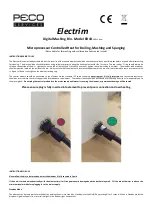
KegMaster
™
XL User Manual
Page 14 of 18
Keg King is a registered business name of MCH Australia Pty Ltd
Balancing your Keg System with CO
2
Balancing your keg system is vital for optimum draft beer performance and is especially important when
using CO
2
to dispense the beer. To balance your keg system correctly we must first understand
Carbonation Level and Keg Storage Temperature.
Carbonation Level
Different beers are carbonated at different levels. The carbonation is measured in “volumes of
carbonation
”. Most draft beers have a carbonation level of about 2.6
‐
2.8 volumes of carbonation.
(see Table 1.1).
Keg Storage Temperature
Keg Storage temperature is best measured using a thermometer. Put a full glass of water in the fridge
with the keg for 2hrs with a thermometer in the glass. Take a reading with the thermometer. This will
give a true reflection of the keg storage temperature. In order to pour without excessive head, the keg
storage temperature of most beers should be between 0
°
C up to 2.5
°
C. Some very lightly carbonated
beers such as English Ales can be dispensed as high as 8
°
C.
Once you know what carbonation level is (if you do not know assume 2.6 volumes of carbonation) and
your keg storage temperature use Table 1.1 to work out the correct dispense pressure. For example, if
your keg storage temperature is 1C and the carbonation level is 2.6 volumes then the equilibrium
pressure is 70kPa (10.2PSI). The dispense pressure should be 10% above the equilibrium pressure. So,
you should set your regulator dispense pressure at 77kPa (11.2PSI).
Setting your dispense pressure below the equilibrium pressure will cause the beer to go flat over time.
Setting the dispense pressure above the equilibrium pressure will cause the beer to become more
carbonated over time.
NOTE:
Many people make the mistake of using the keg dispense pressure to increase or decrease the
flow speed of the beer out of the tap.
THIS IS INCORRECT
. When using CO
2
to dispense, the dispense
pressure must be set according to Table 1.1. The method to adjust the speed of flow is to adjust the beer
line length and diameter.
Beer line diameter and length adjustment
The beer line on a kegerator is not just a hose to get beer from the keg to tap. It also performs the
important function of applying “flow resistance”. With too little flow resistance the beer will come out
of
the tap too fast. With too much flow resistance the beer will come out of the tap too slow. Small internal
diameter (ID) beer line will apply more flow resistance and longer beer line will also apply more flow
resistance. Most domestic systems work well with the following line length/diameter:
4mm ID Beer Line: 1.5
‐
2.5 Meters
5mm ID Beer Line: 3
‐
4.5 Meters
6mm ID Beer Line: 5
‐
10 Meters
Small ID beer line is often the best choice for kegerators as it means the customer can use a shorter beer
line which is less messy inside the fridge. It also minimizes the amount of beer sitting in the beer lines.
Using 4mm ID beer line you will have 12.5ml per meter in the beer line and a total of approx. 22.5ml.
Using 5mm ID beer line you will have 20ml per meter in the beer line and a total of approx. 70ml.
Using 6mm ID beer line you will have 28ml per meter in the beer line and a total of approx. 210ml.
For the above reasons 4mm ID beer line is often the best choice however the small ID makes it difficult
for some customers to fit the ID over the barb fittings on the keg
coupler or ball lock disconnects.
If using 4mm ID, the user may need to stretch the beer line open
slightly so it can fit onto the barbs of some of the fittings. The
perfect tool for this job is a set of needle nose pliers. Heat the
beer line in some boiling water for 30 seconds to soften then
push onto the needle nose pliers to stretch the internal diameter.
Open the handles on the pliers to further stretch the beer line.




































